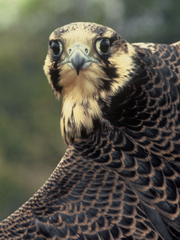|
PEREGRINE FALCON } Falco peregrinus

|
RANGE: Widespread across the globe, with the exception of the poles, very high mountains, and most tropical rainforests
STATUS: NatureServe deems the peregrine Apparently Secure; IUCN calls the bird a species of Least Concern
THREATS: In the ’50s, ’60s and ’70s, the broadcast pesticide DDT decimated populations of peregrines and other top-of-the-food-chain raptors; since the chemical’s U.S. ban, they’ve rebounded.
Peregrines are large, crow-sized falcons with the ability to reach speeds over 200 miles per hour, making them probably the fastest animals in the world. Their diets consist mostly of medium-sized birds, but peregrines will occasionally hunt small mammals, reptiles, or even insects. They reach sexual maturity at one year and mate for life. Numerous subspecies have been described, with about 19 accepted by the Handbook of the Birds of the World. They’ve been used in falconry for more than 3,000 years, beginning with nomads in central Asia, and increasingly they inhabit cities, where they nest on tall buildings.
|